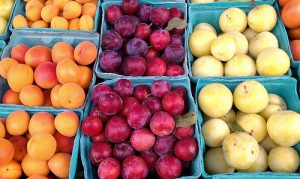Whole Foods for some, Bodegas for others

DCentric
Organic fruit at a D.C. Farmers' Market
I just had a conversation about this with one of you yesterday, about the stark disconnect and borderline shame I felt when I came home after buying cheese, local plum chutney and organic bread for entertaining– and walked right in to a display for a food drive. Newsweek is thinking about food inequality, too:
Alexandra says she spends hours each day thinking about, shopping for, and preparing food. She is a disciple of Michael Pollan, whose 2006 book The Omnivore’s Dilemma made the locavore movement a national phenomenon, and believes that eating organically and locally contributes not only to the health of her family but to the existential happiness of farm animals and farmers—and, indeed, to the survival of the planet. “Michael Pollan is my new hero, next to Jimmy Carter,” she told me. In some neighborhoods, a lawyer who raises chickens in her backyard might be considered eccentric, but we live in Park Slope, Brooklyn, a community that accommodates and celebrates every kind of foodie. Whether you believe in eating for pleasure, for health, for justice, or for some idealized vision of family life, you will find neighbors who reflect your food values. In Park Slope, the contents of a child’s lunchbox can be fodder for a 20-minute conversation.
Over coffee, I cautiously raise a subject that has concerned me of late: less than five miles away, some children don’t have enough to eat; others exist almost exclusively on junk food. Alexandra concedes that her approach is probably out of reach for those people.
Tiffiney Davis, a single mom, lives about four miles away from me, in subsidized housing, in a gentrifying neighborhood called Red Hook. Steps from her apartment, you can find ample evidence of foodie culture: Fairway, the supermarket where I buy my Dutch cheese, is right there, as is a chic bakery, and a newfangled lobster pound. Davis says she has sometimes worried about having enough food. She works in Manhattan, earning $13 an hour for a corporate catering company (which once had a contract with NEWSWEEK), and she receives food stamps. She spends $100 a week on food for herself and her two kids. Sometimes she stretches her budget by bringing food home from work.
Davis is sheepish about what her family eats for breakfast. Everybody rises at 6, and there’s a mad rush to get the door, so often they eat bodega food. Her daughter, Malaezia, 10, will have egg and cheese on a roll; her son, 13-year-old Tashawn, a muffin and soda. She herself used to pop into at Dunkin’ Donuts for two doughnuts and a latte, but when New York chain restaurants started posting calories on their menus, she stopped. “I try my best to lessen the chemicals and the fattening stuff,” she says, “but it’s hard.”
The rest is here.







